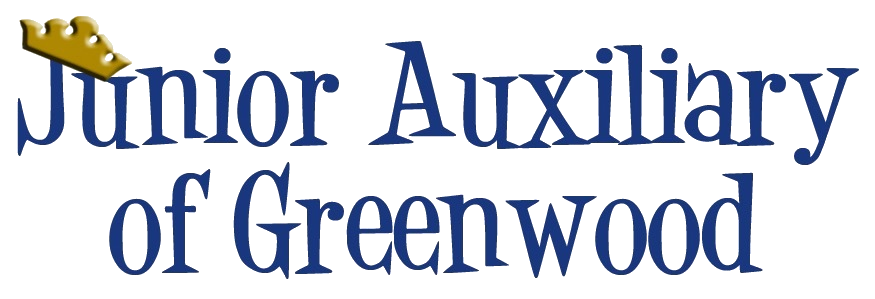In 1933, Mrs. Mildred S. Topp, a well known author, with a group of young ladies realized the need of a volunteer welfare organization in Greenwood. These were depression years with starving people in Greenwood. The young ladies met and established the “Welfare League”.
The projects of the “League” were many during those first years. Some of the projects were a free clinic, a day nursery, helping with PTA projects, and WPA projects. The fund raising projects were charity balls, plays, and raffles. The League joined other organizations in a Christmas Tree, Toys for Tots, and other endeavors.
In May of 1938, the name of the League was changed to Junior Auxiliary. The Auxiliary continued to work with the underprivileged children. A clinic that met regularly was established in the Rose Community Building with a doctor and nurse performing examinations. A dental hygienist cleaned and checked teeth with Auxiliary members serving as clerks, nurse aids, and motor pool.
The children were given vaccinations and shots and any follow up treatment. A Food room was opened with each member delivering milk, cereal, fruit, and cod-liver oil to “her family” once a week.
In February of 1941, the Greenwood Junior Auxiliary received its charter of Incorporation from the Secretary of State. It was one of the Nine Charter chapters of the National Association of Junior Auxiliary. Those ladies listed on the Incorporation charter are: Miss Mary Elizabeth Montjoy, Mrs. Mary Jayne Poindexter, Mrs. Dorothy Sabin Montjoy, Mrs. Janie Mann Craig, Mrs. Augusta Claiborne Barnwell.
The first meeting was held April 2, 1941. The following officers were elected: Miss Elizabeth Montjoy – President; Mrs. R. Barnwell – Vice President; Mrs. W.M. Whittington, JR. – Secretary; Mrs. Paul Montjoy- Treasurer.
The welfare projects continued. When the USA went into World War II, new problems faced the Junior Auxiliary. The members voted to roll bandages for the Red Cross, help at the U.S.O. and local Air Base. The most unusual and outstanding project of this war time era was the publishing of the “G.I. Jabber”. This was a paper published by Ellett Lawrence, Tom Sheppard and the Junior Auxiliary. The members were in contact with parents of boys in the service and wrote about where the boys were and their address.
The money for these projects was raised through the Mule Races. The races were known far and wide with planters bringing Mules from all three neighboring states. It was hard for the Auxiliary members, but the profit made it worthwhile. In 1945 the Junior Auxiliary house was built behind Williams school. A new project was introduced – a day nursery. It was opened from 8 until 3:30 five days a week. Auxiliary members assisted the employed teacher, ran motor pools and served hot lunches to the pre-school children. At night, the house was used for craft classes, square dance lessons, and other activities under the leadership of the members. The Food room and clinic began to meet at the house on Saturday mornings. A new finance project was undertaken, “The Follies”. Fun was had by all the community as talent was displayed on the stage.
The Greenwood chapter of NAJA was the host chapter of the 1945 Annual Convention.
In 1952-53, the Greenwood Junior Auxiliary was selected the most outstanding chapter. This honor was accepted by Mrs. G.K. Wade at the National Convention. The Greenwood chapter is proud to have three National Presidents. They are Mrs. Ella Lay Turner Merrick, Mrs. F. C. Ewing, Mrs. Marion Moor.
In the early 1950s, with the cooperation of Mr. Percy DeLoach, Jr., the Auxiliary sponsored their first Fall style Show. In 1957, the first Cotton Ball was held with Mr. Luther Wade as King and Carolyn Provine as Queen. Cotton Ball remains the Auxiliary’s primary fund raising project.
In 1958, the Junior Auxiliary established a Dental Room at the Greenwood Leflore Hospital. Children in need of dental care were taken weekly to the hospital by Auxiliary members to be seen by dentists giving of their time to treat the children.
A cripple children clinic was held monthly at the Health Department with the Auxiliary members serving as clerks. Due to the overcrowded conditions of Williams School, the Auxiliary was forced to give up their Day Nursery so the school could use the building.
With the return of the house, the Junior Auxiliary opened East Greenwood Kindergarten in 1969.
Through the years the Auxiliary has had many smaller projects such as sponsoring traveling plays, special movies, war blood drives, assisting the Red Cross, Salvation Army, PTA’s, and Garden Clubs. They have also assisted the Health Department in vaccinations and new shots as they arrive. They have always had Christmas Boxes and gathered toys and clothes for children.
Today the Auxiliary is true to its founders by carrying on the work for the betterment of children and by taking an active part in local civic endeavors.
